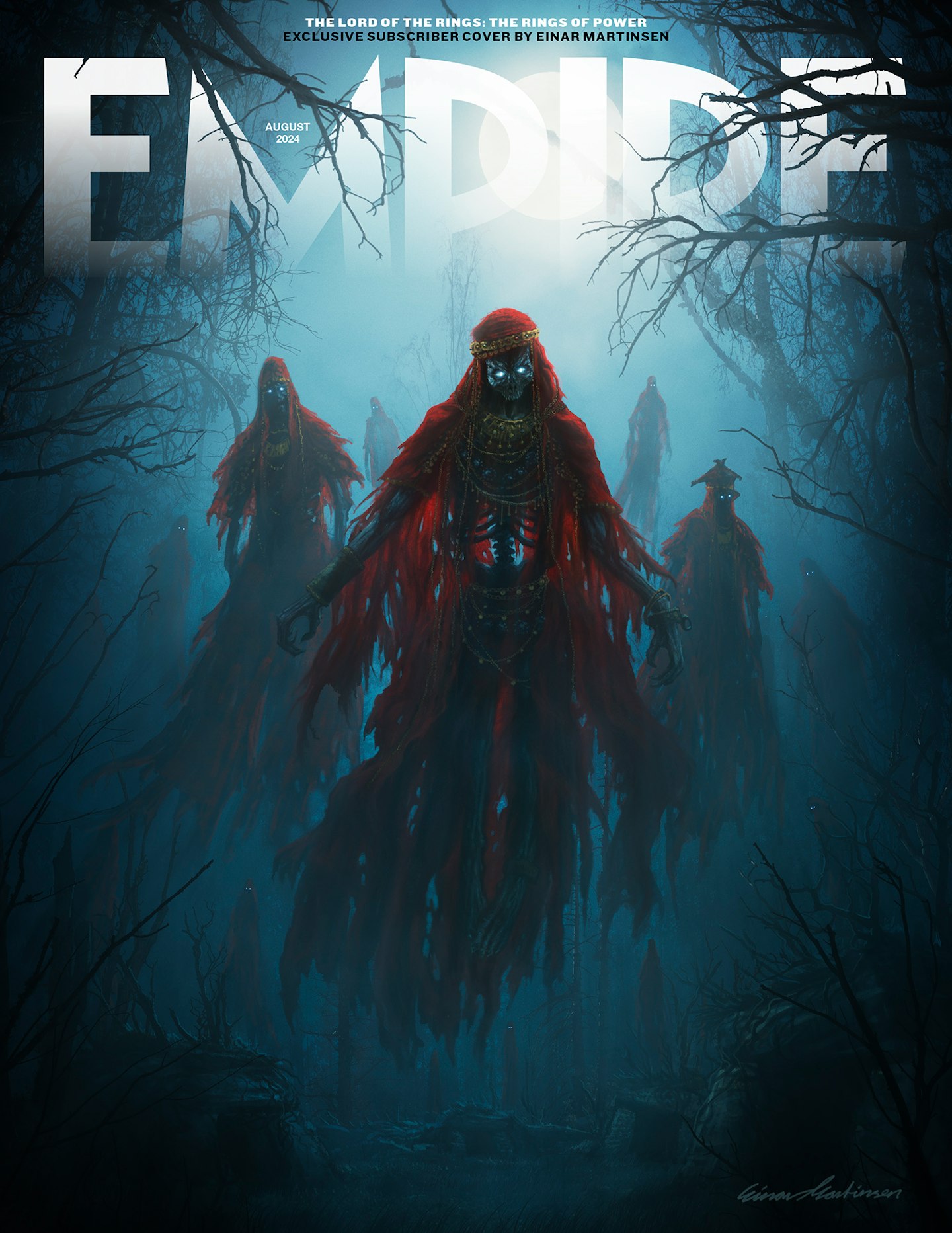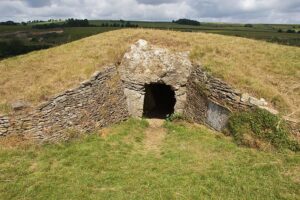There’s never been a better time to be a fan of three specific consecutive chapters of The Fellowship Of The Ring that have never been adapted from page to screen. The Old Forest, In The House Of Tom Bombadil, and Fog On The Barrow-downs make up a strange, at times surreal, and largely self-contained story that seemingly holds up the book’s overarching narrative instead of moving it forward – and for filmmakers Peter Jackson and Ralph Bakshi, that’s justification enough for their decision to pretend the Hobbits made it from the Shire to Bree without incident along the way. The plot is essentially unaffected (the Hobbits are given their swords by Aragorn, who conveniently has three small swords on his person), and moves to its destination quicker. But so much texture is lost. The world of Middle-earth is less rich, less vibrant, without Tom Bombadil and Goldberry; less dangerous, less of a character in its own right, without Old Man Willow and the Barrow-wights. These chapters play an underappreciated role in making The Lord Of The Rings, and this year, they’re finally being paid their dues.

As previously revealed by Vanity Fair, the upcoming second season of The Rings Of Power will feature Tom Bombadil, an enigmatic character who was already capering about in J.R.R. Tolkien’s head years before he started writing The Lord Of The Rings, but became so firmly grounded in Middle-earth as to now be frequently associated with the in-universe God. Recently, Empire Magazine confirmed that the Barrow-wights, terrifying adversaries of Bombadil, would also appear in season two; which did not come as much of a surprise to keen-eyed fans who had already caught fleeting glimpses of them in the trailer and accompanying behind-the-scenes video released over a month ago, but did allow us to get a much closer look at how Amazon is adapting these iconic monsters for television. So let’s get into it.
First, however, I feel like “barrows” and “wights” are sufficiently unfamiliar concepts to the general audience that a brief explanation is in order. Barrows, or tumuli, are tombs covered by a mound of earth, and while the practice of building them was fairly common across the world in ancient times, with examples everywhere from France to Japan to Australia, Tolkien’s barrows are distinctly English, while the incorporeal, undead monsters inhabiting these mounds come from Norse folklore. There are several words in Old Norse to describe such a creature, including draugr or vættr, which was translated into English as wight (an existing, if somewhat archaic Old English word that once applied to just about anything living, but came to refer almost exclusively to supernatural beings). Tolkien had probably also encountered the specific term “Barrow-wight” at least once, in Eiríkr Magnússon and William Morris’ Grettis Saga (1869), which adapts the Old Norse word haugbúi or “barrow-dweller” thusly.

Draugar, traditionally, are understood to be something other than ghosts, a kind of parasitic spirit that possesses and reanimates dead bodies for its own malevolent purposes, and may fiercely guard a treasure (hence their association with barrows in particular, which often housed a deceased ruler’s riches as well as their remains), or wander around by night in search of its prey. Tolkien’s wights check all the boxes. Though little is said of how they came to be, we know for a fact that they were not innate to the barrows:
“In the days of Argeleb II the plague came into Eriador from the South-east, and most of the people of Cardolan perished, especially in Minhiriath. The Hobbits and all other peoples suffered greatly, but the plague lessened as it passed northwards, and the northern parts of Arthedain were little affected. It was at this time that an end came of the Dúnedain of Cardolan, and evil spirits out of Angmar and Rhudaur entered into the deserted mounds and dwelt there.”
— The Lord Of The Rings: The Return Of The King: Appendix A; (iii) Eriador, Arnor, And The Heirs Of Isildur
In Unfinished Tales, the appearance of the wights in Cardolan is explicitly linked with the Witch-king of Angmar, mightiest of the nine Ringwraiths, whom Tolkien at one point conceived of as wights themselves:
“[The Witch-king] had known something of the country long ago, in his wars with the Dúnedain, and especially of the Tyrn Gorthad of Cardolan, now the Barrow-downs, whose evil wights had been sent there by himself.”
— Unfinished Tales: The Hunt For The Ring
Whether the wights were creations of the Witch-king or had merely fallen under his control is a mystery. During the events of The Lord Of The Rings, he again “roused” the wights in an (ultimately unsuccessful) effort to blockade the Shire and prevent Frodo Baggins from escaping to Rivendell. The wights may have perished off-page when the Witch-king was killed in the Battle of the Pelennor Fields, or afterwards when the power of the Nine Rings was ended, but for my part I believe they were older than either Rings or Ringwraiths. The wight’s song speaks of a “dark lord”, which can be read as a reference to Sauron, of course, but looks forward to a time when he will lift his hand to bring about death and destruction on a cosmic scale, extinguishing the sun, moon and stars in a black wind. Sauron, for all his many faults, is not a nihilist (part of what makes him so interesting to me), and the wight’s imagined future sounds a lot more like the universe according to Morgoth.
All of which is to say that I personally have no problem with wights appearing in The Rings Of Power, an Age of the world before the wars in Arnor where they make their official entrance into historical record. The show could call them wights rather than Barrow-wights to clear up any lingering confusion, but even that I think is unnecessary as long as these wights are not already inhabiting the Barrow-downs east of the Shire – and from the looks of it, they’re not. The trailer and first-look images show Galadriel, Elrond, and a squadron of Elven warriors surrounded by wights in a swampy forest, while the Barrow-downs are described and consistently depicted in artwork as “a country of grass and short springy turf”, devoid of trees or visible water. One could argue this is the result of unchecked deforestation by Númenórean colonizers, and while I wouldn’t normally expect a commitment to fictional ecohistorical accuracy from a show, I remembered that the marketing for The Rings Of Power kicked off with a remarkably accurate map of Middle-earth in the early Second Age, so I checked…and the forests, while blanketing much of Eriador, deliberately skirt around the Barrow-downs.

So then, where are these wights from? That’s a question that has become especially relevant now that we’ve seen the wights up-close via Empire, because their costumes – specifically their headwear and jewelry – have raised legitimate concerns of orientalism. Regardless of whether or not The Rings Of Power‘s costume department meant anything by dressing monsters in what is seemingly SWANA and Central Asian traditional clothing, I believe it is important to amplify these concerns. The Rings Of Power, and all adaptations of J.R.R. Tolkien’s works, have a responsibility to tackle head-on the orientalist and racist tropes that he wove into the text (again, whether intentionally or not). I would not see The Rings Of Power repeat the critical mistake Peter Jackson made when he opted instead to ignore and arguably even lean into the xenophobic connotations of a story about predominantly white heroes from the West cutting down hordes of nameless dark-skinned enemies out of the East, which in the aftermath of 9/11 made the films and books extremely popular amongst white Christian nationalists and Islamophobes (including Gimli actor and voice of Treebeard, John Rhys-Davies), who have dominated the fandom space and tried to shape mainstream perception of The Lord Of The Rings as an exclusively white and Christian story for the last two decades, in part because they were never challenged.
The Rings Of Power played an indirect role in exposing the fandom’s racism and revitalizing interest in the study of racist themes in Tolkien’s works, but has actually done surprisingly little in and of itself to challenge the status quo, and in some ways is decidedly regressive. Many fans raised eyebrows at the decision to erase important examples of gender nonconformity in Middle-earth by depicting most Elven men (and only the men) with short hair and Dwarven women without facial hair, while others noted how odd it was that most of the nameless Elven women in Lindon wear veils and nun-like garments. Some of these issues have been addressed heading into season two (there are more Elven men with long hair now, and Princess Disa is growing out her sideburns), but the Barrow-wights serve as a reminder that The Rings Of Power still has a long way to go in confronting the legacy of orientalism in Tolkien’s works that has overshadowed every adaptation. With the series expanding its scope to encompass the eastern lands of Rhûn, while in the real world, Islamophobic and xenophobic rhetoric against SWANA people is on the rise, it’s more important than ever that they make the effort.
What do you think of the Barrow-wights, their look, and the role they could potentially play in The Rings Of Power season two? Share your own thoughts, theories, and opinions, in the comments below!